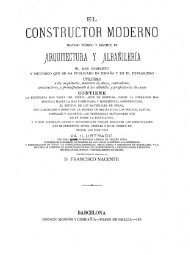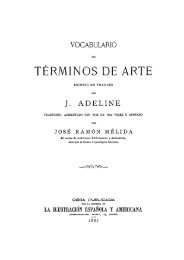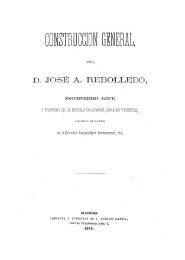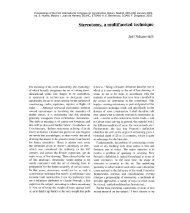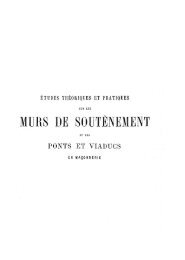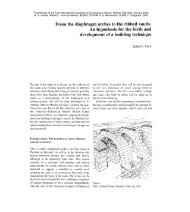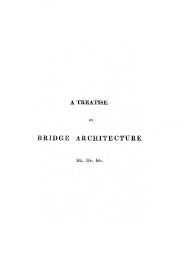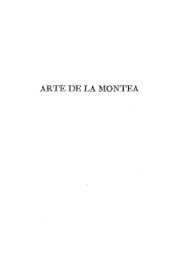Helical masonry vaulted staircase in Palladio and Vignola's ...
Helical masonry vaulted staircase in Palladio and Vignola's ...
Helical masonry vaulted staircase in Palladio and Vignola's ...
Create successful ePaper yourself
Turn your PDF publications into a flip-book with our unique Google optimized e-Paper software.
300 A. Barbieri, A. Di Tommaso, R. Massarotto<br />
spread everywhere. Indication of <strong>staircase</strong> design,<br />
comfort, safety <strong>and</strong> collocation <strong>in</strong> build<strong>in</strong>g could be<br />
found <strong>in</strong> every Renaissance treatise of Architecture.<br />
Only the last Renaissance treatise <strong>in</strong>cludes <strong>in</strong>dications<br />
of build<strong>in</strong>g procedures: Scamozzi's treatise at the<br />
beg<strong>in</strong>n<strong>in</strong>g of XVII century.<br />
The Vitruvio's treatise is the reference for<br />
architects dur<strong>in</strong>g the Humanism <strong>and</strong> the Renaissance<br />
(Gambardella, 1993). However, the <strong>staircase</strong>s are not<br />
taken <strong>in</strong>to much consideration <strong>in</strong> this document; <strong>in</strong><br />
fact, as Fra Giocondo Da Verona compla<strong>in</strong>ed <strong>in</strong><br />
edition of 1590, the rules for <strong>staircase</strong>s design are<br />
miss<strong>in</strong>g. This is due lo the fact that the <strong>staircase</strong> is not<br />
<strong>and</strong> architectonical element <strong>in</strong> the roman domus,<br />
whereas it is an impos<strong>in</strong>g base <strong>in</strong> the public build<strong>in</strong>gs,<br />
<strong>and</strong> often it becomes an architecture itself, as Serlio<br />
said (Serlio 1584).<br />
Already <strong>in</strong> «De Re Aedificatoria» of Leon Battista<br />
Alberti (Alberti 1485), the <strong>staircase</strong> has an important<br />
role as useful element <strong>in</strong> the build<strong>in</strong>g but, at the same<br />
time, its presence makes the design difficult. The<br />
<strong>staircase</strong> is so necessary that «who would not like the<br />
<strong>staircase</strong>s h<strong>in</strong>der, he avoids h<strong>in</strong>der<strong>in</strong>g the <strong>staircase</strong>s»,<br />
underl<strong>in</strong><strong>in</strong>g that it is not possible to neglect the<br />
place devoted to them, although this could <strong>in</strong>duce<br />
some difficulties to the designer <strong>in</strong> term of space<br />
organisation.<br />
In Francesco di Giorgio Mart<strong>in</strong>i' s treatise, titled<br />
«Architettura civile e militare», the w<strong>in</strong>d<strong>in</strong>g <strong>staircase</strong><br />
is represented (Gambardella, 1993). It is located <strong>in</strong> a<br />
tower, as only entrance to a second defensive tower;<br />
<strong>in</strong> this way, whereas the enemy cover the long climb,<br />
the soldiers organise the defence. The <strong>staircase</strong><br />
becomes tool of war <strong>and</strong> life.<br />
If, <strong>in</strong> Cataneo, the courtyard is the centre of build<strong>in</strong>g<br />
<strong>and</strong> the <strong>staircase</strong>s regulate only the space organisation<br />
(Barozzi <strong>and</strong> Cataneo 1560), Alvise Cornaro <strong>in</strong> 1556<br />
wrote (Barozzi <strong>and</strong> Cataneo 1560): «the designer has<br />
to give space to <strong>staircase</strong>s <strong>and</strong> not h<strong>in</strong>der them,<br />
because h<strong>in</strong>dered, they h<strong>in</strong>der», follow<strong>in</strong>g the same<br />
pr<strong>in</strong>cipIe of Alberti.<br />
In Sebastiano Serlio's treatise (Serlio 1584), «l<br />
sette libri dell' architettura», the author declares that<br />
the helical <strong>staircase</strong>s are «arduous structures to be<br />
built so that who is not able. to design the traditional<br />
ones he should not even try to design those are more<br />
complex». The <strong>staircase</strong> is considered a difficult<br />
element which is underst<strong>and</strong>able only to expert<br />
designer. He <strong>in</strong>serts the <strong>staircase</strong> <strong>in</strong> some perspective<br />
studies <strong>and</strong> he tries to fumish an h<strong>and</strong>book for<br />
designer. He takes aga<strong>in</strong> the theme <strong>in</strong> volume III,<br />
dedicated to Roman antiquities, where he writes<br />
about the <strong>staircase</strong> -build<strong>in</strong>g: Colosseo. In the<br />
analysis of Roman architectures, Serlio emphasises<br />
well made <strong>staircase</strong>s, examples have to be followed<br />
by the contemporary architects. The Bramante's<br />
helical <strong>staircase</strong> st<strong>and</strong>s out among the quotations; it is<br />
the only modem architecture, which has to be<br />
admired <strong>and</strong> studied. It is po<strong>in</strong>ted out that the<br />
stairwell is designed carefully <strong>in</strong> every plate;<br />
evidently, the architect considered the <strong>staircase</strong> an<br />
important <strong>and</strong> difficult element <strong>in</strong> the architecture.<br />
Giorgio Vasari, <strong>in</strong>



